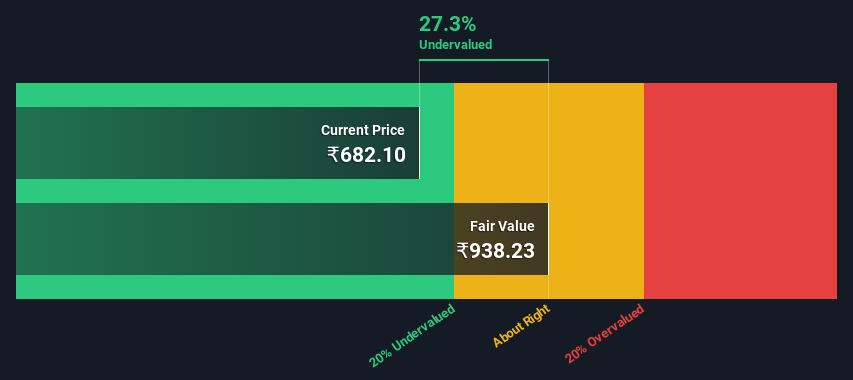- India
- /
- Real Estate
- /
- NSEI:BRIGADE
Is Brigade Enterprises Limited (NSE:BRIGADE) Trading At A 27% Discount?

Key Insights
- Using the 2 Stage Free Cash Flow to Equity, Brigade Enterprises fair value estimate is ₹938
- Current share price of ₹682 suggests Brigade Enterprises is potentially 27% undervalued
- The ₹673 analyst price target for BRIGADE is 28% less than our estimate of fair value
Does the November share price for Brigade Enterprises Limited (NSE:BRIGADE) reflect what it's really worth? Today, we will estimate the stock's intrinsic value by taking the forecast future cash flows of the company and discounting them back to today's value. The Discounted Cash Flow (DCF) model is the tool we will apply to do this. Before you think you won't be able to understand it, just read on! It's actually much less complex than you'd imagine.
Remember though, that there are many ways to estimate a company's value, and a DCF is just one method. If you want to learn more about discounted cash flow, the rationale behind this calculation can be read in detail in the Simply Wall St analysis model.
See our latest analysis for Brigade Enterprises
Is Brigade Enterprises Fairly Valued?
We use what is known as a 2-stage model, which simply means we have two different periods of growth rates for the company's cash flows. Generally the first stage is higher growth, and the second stage is a lower growth phase. In the first stage we need to estimate the cash flows to the business over the next ten years. Where possible we use analyst estimates, but when these aren't available we extrapolate the previous free cash flow (FCF) from the last estimate or reported value. We assume companies with shrinking free cash flow will slow their rate of shrinkage, and that companies with growing free cash flow will see their growth rate slow, over this period. We do this to reflect that growth tends to slow more in the early years than it does in later years.
A DCF is all about the idea that a dollar in the future is less valuable than a dollar today, so we need to discount the sum of these future cash flows to arrive at a present value estimate:
10-year free cash flow (FCF) forecast
| 2024 | 2025 | 2026 | 2027 | 2028 | 2029 | 2030 | 2031 | 2032 | 2033 | |
| Levered FCF (₹, Millions) | ₹3.80b | ₹11.3b | ₹16.6b | ₹21.1b | ₹25.5b | ₹29.7b | ₹33.8b | ₹37.7b | ₹41.5b | ₹45.3b |
| Growth Rate Estimate Source | Analyst x3 | Analyst x4 | Analyst x2 | Est @ 26.83% | Est @ 20.80% | Est @ 16.58% | Est @ 13.63% | Est @ 11.56% | Est @ 10.11% | Est @ 9.10% |
| Present Value (₹, Millions) Discounted @ 16% | ₹3.3k | ₹8.3k | ₹10.6k | ₹11.6k | ₹12.0k | ₹12.1k | ₹11.8k | ₹11.3k | ₹10.8k | ₹10.1k |
("Est" = FCF growth rate estimated by Simply Wall St)
Present Value of 10-year Cash Flow (PVCF) = ₹102b
We now need to calculate the Terminal Value, which accounts for all the future cash flows after this ten year period. The Gordon Growth formula is used to calculate Terminal Value at a future annual growth rate equal to the 5-year average of the 10-year government bond yield of 6.7%. We discount the terminal cash flows to today's value at a cost of equity of 16%.
Terminal Value (TV)= FCF2033 × (1 + g) ÷ (r – g) = ₹45b× (1 + 6.7%) ÷ (16%– 6.7%) = ₹511b
Present Value of Terminal Value (PVTV)= TV / (1 + r)10= ₹511b÷ ( 1 + 16%)10= ₹114b
The total value, or equity value, is then the sum of the present value of the future cash flows, which in this case is ₹216b. To get the intrinsic value per share, we divide this by the total number of shares outstanding. Compared to the current share price of ₹682, the company appears a touch undervalued at a 27% discount to where the stock price trades currently. The assumptions in any calculation have a big impact on the valuation, so it is better to view this as a rough estimate, not precise down to the last cent.

The Assumptions
We would point out that the most important inputs to a discounted cash flow are the discount rate and of course the actual cash flows. Part of investing is coming up with your own evaluation of a company's future performance, so try the calculation yourself and check your own assumptions. The DCF also does not consider the possible cyclicality of an industry, or a company's future capital requirements, so it does not give a full picture of a company's potential performance. Given that we are looking at Brigade Enterprises as potential shareholders, the cost of equity is used as the discount rate, rather than the cost of capital (or weighted average cost of capital, WACC) which accounts for debt. In this calculation we've used 16%, which is based on a levered beta of 1.135. Beta is a measure of a stock's volatility, compared to the market as a whole. We get our beta from the industry average beta of globally comparable companies, with an imposed limit between 0.8 and 2.0, which is a reasonable range for a stable business.
SWOT Analysis for Brigade Enterprises
- Earnings growth over the past year exceeded its 5-year average.
- Debt is well covered by cash flow.
- Dividends are covered by earnings and cash flows.
- Earnings growth over the past year underperformed the Real Estate industry.
- Interest payments on debt are not well covered.
- Dividend is low compared to the top 25% of dividend payers in the Real Estate market.
- Annual earnings are forecast to grow faster than the Indian market.
- Trading below our estimate of fair value by more than 20%.
- Revenue is forecast to grow slower than 20% per year.
Looking Ahead:
Whilst important, the DCF calculation shouldn't be the only metric you look at when researching a company. The DCF model is not a perfect stock valuation tool. Instead the best use for a DCF model is to test certain assumptions and theories to see if they would lead to the company being undervalued or overvalued. For example, changes in the company's cost of equity or the risk free rate can significantly impact the valuation. Why is the intrinsic value higher than the current share price? For Brigade Enterprises, there are three pertinent factors you should further research:
- Risks: Every company has them, and we've spotted 2 warning signs for Brigade Enterprises (of which 1 is concerning!) you should know about.
- Future Earnings: How does BRIGADE's growth rate compare to its peers and the wider market? Dig deeper into the analyst consensus number for the upcoming years by interacting with our free analyst growth expectation chart.
- Other High Quality Alternatives: Do you like a good all-rounder? Explore our interactive list of high quality stocks to get an idea of what else is out there you may be missing!
PS. The Simply Wall St app conducts a discounted cash flow valuation for every stock on the NSEI every day. If you want to find the calculation for other stocks just search here.
Valuation is complex, but we're here to simplify it.
Discover if Brigade Enterprises might be undervalued or overvalued with our detailed analysis, featuring fair value estimates, potential risks, dividends, insider trades, and its financial condition.
Access Free AnalysisHave feedback on this article? Concerned about the content? Get in touch with us directly. Alternatively, email editorial-team (at) simplywallst.com.
This article by Simply Wall St is general in nature. We provide commentary based on historical data and analyst forecasts only using an unbiased methodology and our articles are not intended to be financial advice. It does not constitute a recommendation to buy or sell any stock, and does not take account of your objectives, or your financial situation. We aim to bring you long-term focused analysis driven by fundamental data. Note that our analysis may not factor in the latest price-sensitive company announcements or qualitative material. Simply Wall St has no position in any stocks mentioned.
About NSEI:BRIGADE
Brigade Enterprises
Provides real estate development, leasing, and related services in India.
Solid track record with excellent balance sheet.
Similar Companies
Market Insights
Community Narratives



